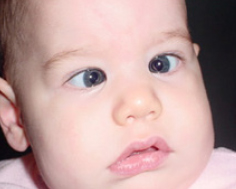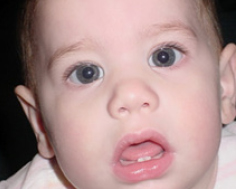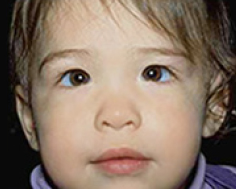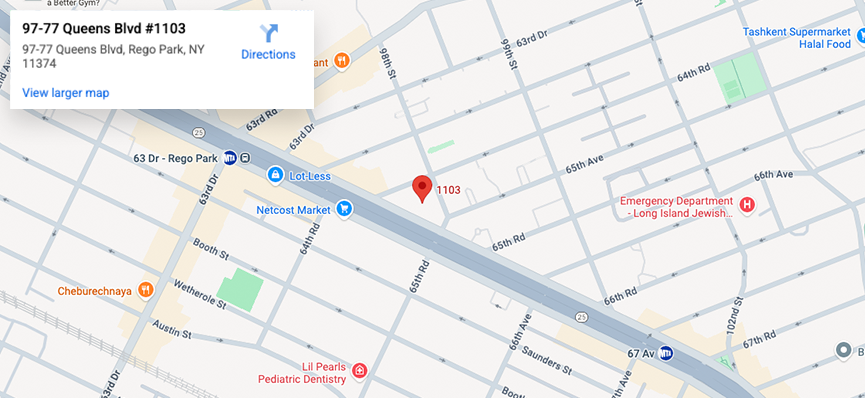Esotropia is a type of strabismus or eye misalignment. In esotropia, the eyes are “crossed”; that is, while one eye looks straight ahead, the other eye is turned in toward the nose. This inward deviation of the eyes can begin in infancy or later in childhood.
CONGENITAL (INFANTILE) ESOTROPIA
Congenital (infantile) esotropia is a type of strabismus which first appears sometime within the first six months of life. This esotropia may be present at birth but often develops within the first few months. In the first months of life, it is common for the eyes to intermittently become misaligned. If a misalignment of the eyes persists after the first few months, a consultation with a pediatric ophthalmologist is required.
One to two percent of children have congenital esotropia. Though the cause is unknown, it is thought that the underlying problem lies in the brain’s inability to coordinate the movement of the eyes. These children will often alternate their vision between the two eyes by sometimes crossing one eye, and at other times the other. Some children will constantly cross the same eye. This is often an indication that amblyopia, or decreased vision, is developing in one eye.
Treatment of congenital esotropia usually requires eye muscle surgery. Before surgery is performed, other factors must be considered. If amblyopia has developed in one eye, this poor vision must be treated right away. This is accomplished by patching the better eye to force the brain to use the eye with poorer vision. Though this will not correct the eye crossing, it will equalize the vision which improves the prognosis for a successful outcome from surgery. The presence of farsightedness must also be detected prior to an operation. Though this is an uncommon cause of esotropia in infants, glasses must be tried when there is significant farsightedness present as glasses, alone may diminish the eye crossing.
Children do not outgrow infantile esotropia. Surgical correction is usually recommended between six and nine months of age. The reasons for correction go beyond the obvious drastic improvement in the child’s appearance. When the eyes are misaligned in childhood, binocular vision, or the ability of the brain to use the two eyes together, does not develop. Early alignment of the eyes allows for the development of the brain’s ability to experience normal depth perception and fine 3-dimensional vision. Achieving this binocularity at a young age will also afford a child the best chance of maintaining normal ocular alignment throughout life. Additionally, a child with good ocular alignment is at decreased risk for developing amblyopia.
Even after successful surgery, periodic follow-up is necessary to detect associated eye problems. Vertical misalignments of the eye, especially when looking to the side, recurrent eye crossing and amblyopia may occur months, years or decades after successful eye muscle surgery.
ACCOMMODATIVE ESOTROPIA
Accommodative esotropia is a form of strabismus due to a need for farsighted glasses (see the Accommodative Esotropia section for more information).
ACQUIRED NON-ACCOMMODATIVE ESOTROPIA
Esotropia can occur after infancy and not be responsive to farsighted glasses, thereby not falling into the categories of congenital (infantile) or accommodative esotropia which are described elsewhere on this web site. Acquired esotropia can have multiple causes. Most common are children who have been farsighted for awhile and have not had glasses, or children who were initially responsive to glasses but later developed an additional eye crossing even when wearing the proper glasses. All children with acquired eye crossing require a prompt evaluation by a pediatric ophthalmologist. Eye muscle surgery can correct such deviations and restoration of binocular vision is usually possible.


Child with infantile esotropia before and after eye muscle surgery.
PSEUDOESOTROPIA
Pseudoesotropia refers to the appearance of crossed eyes in a child whose eyes are actually perfectly aligned. This is common in infants and younger children who have a broad, flat bridge of the nose which allows the skin on the inner part of the eyelids to extend over and cover the inner part of the eye. The sclera (the white part of the eye) closest to the nose becomes covered, especially when the child looks toward either side, and a crossed eye appearance is simulated (see photo below). As the face matures and the nasal bridge grows, the skin is pulled forward and away from the eye, thereby eliminating the crossed eye appearance.

Pseudoesotropia as a result of a broad bridge of the nose. This is not a real eye crossing.
Pediatric Ophthalmic Consultants
40 West 72nd Street, New York, NY 10023 | 212-981-9800
The content of this Web site is for informational purposes only. If you suspect that you or your child has any ocular problem,
please consult your pediatrician, family practitioner, or ophthalmologist to decide if a referral to a pediatric ophthalmologist is required.











































